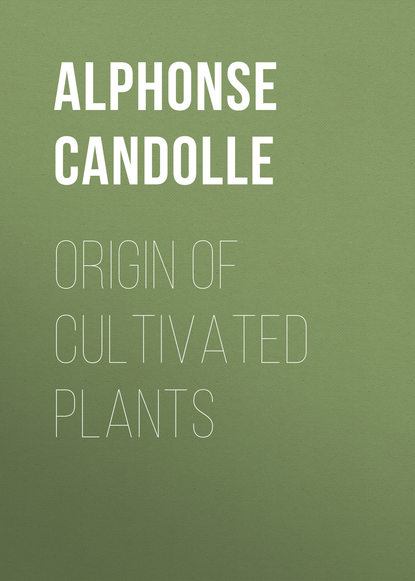По всем вопросам обращайтесь на: info@litportal.ru
(©) 2003-2024.
✖
Origin of Cultivated Plants
Настройки чтения
Размер шрифта
Высота строк
Поля
1469
Loureiro, Fl. Coch., p. 772.
1470
Marcgraf, Brasil., p. 103, and Piso, p. 159, for Brazil; Ximenes in Marcgraf and Hernandez, Thesaurus, p. 99, for Mexico; and the last for St. Domingo and Mexico.
1471
Clusius, Curæ Posteriores, pp. 79, 80.
1472
Martius, Beitr. z. Ethnogr., ii. p. 418.
1473
P. Browne, Jamaica, edit. 2, p. 360. The first edition is of 1756.
1474
The passage of Oviedo is translated into English by Correa de Mello and Spruce, in their paper on the Proceedings of the Linnæan Society, x. p. 1.
1475
De Candolle, Prodr., xv. part 1, p. 414.
1476
Boissier, Fl. Orient., iv. p. 1154; Brandis, Forest Flora of India, p. 418; Webb and Berthelot, Hist. Nat. des Canaries, Botanique, iii. p. 257.
1477
Count Solms Laubach, in a learned discussion (Herkunft, Domestication, etc., des Feigenbaums, in 4to, 1882), has himself observed facts of this nature already indicated by various authors. He did not find the seed provided with embryos (p. 64), which he attributes to the absence of the insect (Blastophaga), which generally lives in the wild fig, and facilitates the fertilization of one flower by another in the interior of the fruit. It is asserted, however, that fertilization occasionally takes place without the intervention of the insect.
1478
Chabas, Mélanges Egyptol., 3rd series (1873), vol. ii. p. 92.
1479
Rosenmuller, Bibl. Alterth., i. p. 285; Reynier, Écon. Publ. des Arabes et des Juifs, p. 470.
1480
Forskal, Fl. Ægypto-Arab., p. 125. Lagarde (Revue Critique d’Histoire, Feb. 27, 1882) says that this Semitic name is very ancient.
1481
Bretschneider, in Solms, ubi supra, p. 51.
1482
Herodotus, i. 71.
1483
Lenz, Botanik der Griechen, p. 421, quotes four lines of Homer. See also Hehn, Culturpflanzen, edit. 3, p. 84.
1484
Hehn, Culturpflanzen, edit. 3, p. 513.
1485
No importance should be attached to the exaggerated divisions made by Gasparini in Ficus carica, Linnæus. Botanists who have studied the fig tree since his time retain a single species, and name several varieties of the wild fig. The cultivated forms are numberless.
1486
Gussone, Enum. Plant. Inarimensium, p. 301.
1487
For the history of the fig tree and an account of the operation (of doubtful utility) which consists in planting insect-bearing Caprifici among the cultivated trees (caprification), see Solms’ work.
1488
Pliny, Hist., lib. xv. cap. 18.
1489
Hehn, Culturpflanzen, edit. 3, p. 513.
1490
Webb and Berthelot, Hist. Nat. des Canaries Ethnogr., p. 186; Phytogr., iii. p. 257.
1491
Duveyrier, Les Touaregs du Nord., p. 193.
1492
Planchon, Étude sur les tufs de Montpellier, p. 63; de Saporta, La flore des tufs quaternaires en Provence, in Comptes rendus de la 32e Session du Congrès Scientifique de France; Bull. Soc. Geolog., 1873-74, p. 442.
1493
See the fine plates published in Tussac’s Flore des Antilles, vol. ii. pls. 2 and 3; and Hooker, Bot. Mag., t. 2869-2871.
Loureiro, Fl. Coch., p. 772.
1470
Marcgraf, Brasil., p. 103, and Piso, p. 159, for Brazil; Ximenes in Marcgraf and Hernandez, Thesaurus, p. 99, for Mexico; and the last for St. Domingo and Mexico.
1471
Clusius, Curæ Posteriores, pp. 79, 80.
1472
Martius, Beitr. z. Ethnogr., ii. p. 418.
1473
P. Browne, Jamaica, edit. 2, p. 360. The first edition is of 1756.
1474
The passage of Oviedo is translated into English by Correa de Mello and Spruce, in their paper on the Proceedings of the Linnæan Society, x. p. 1.
1475
De Candolle, Prodr., xv. part 1, p. 414.
1476
Boissier, Fl. Orient., iv. p. 1154; Brandis, Forest Flora of India, p. 418; Webb and Berthelot, Hist. Nat. des Canaries, Botanique, iii. p. 257.
1477
Count Solms Laubach, in a learned discussion (Herkunft, Domestication, etc., des Feigenbaums, in 4to, 1882), has himself observed facts of this nature already indicated by various authors. He did not find the seed provided with embryos (p. 64), which he attributes to the absence of the insect (Blastophaga), which generally lives in the wild fig, and facilitates the fertilization of one flower by another in the interior of the fruit. It is asserted, however, that fertilization occasionally takes place without the intervention of the insect.
1478
Chabas, Mélanges Egyptol., 3rd series (1873), vol. ii. p. 92.
1479
Rosenmuller, Bibl. Alterth., i. p. 285; Reynier, Écon. Publ. des Arabes et des Juifs, p. 470.
1480
Forskal, Fl. Ægypto-Arab., p. 125. Lagarde (Revue Critique d’Histoire, Feb. 27, 1882) says that this Semitic name is very ancient.
1481
Bretschneider, in Solms, ubi supra, p. 51.
1482
Herodotus, i. 71.
1483
Lenz, Botanik der Griechen, p. 421, quotes four lines of Homer. See also Hehn, Culturpflanzen, edit. 3, p. 84.
1484
Hehn, Culturpflanzen, edit. 3, p. 513.
1485
No importance should be attached to the exaggerated divisions made by Gasparini in Ficus carica, Linnæus. Botanists who have studied the fig tree since his time retain a single species, and name several varieties of the wild fig. The cultivated forms are numberless.
1486
Gussone, Enum. Plant. Inarimensium, p. 301.
1487
For the history of the fig tree and an account of the operation (of doubtful utility) which consists in planting insect-bearing Caprifici among the cultivated trees (caprification), see Solms’ work.
1488
Pliny, Hist., lib. xv. cap. 18.
1489
Hehn, Culturpflanzen, edit. 3, p. 513.
1490
Webb and Berthelot, Hist. Nat. des Canaries Ethnogr., p. 186; Phytogr., iii. p. 257.
1491
Duveyrier, Les Touaregs du Nord., p. 193.
1492
Planchon, Étude sur les tufs de Montpellier, p. 63; de Saporta, La flore des tufs quaternaires en Provence, in Comptes rendus de la 32e Session du Congrès Scientifique de France; Bull. Soc. Geolog., 1873-74, p. 442.
1493
See the fine plates published in Tussac’s Flore des Antilles, vol. ii. pls. 2 and 3; and Hooker, Bot. Mag., t. 2869-2871.





